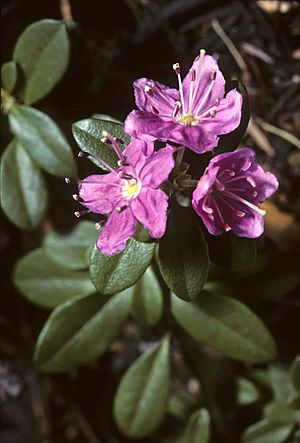North Umpqua kalmiopsis facts for kids
Quick facts for kids North Umpqua kalmiopsis |
|
|---|---|
 |
|
| Conservation status | |
| Scientific classification | |
| Genus: |
Kalmiopsis
|
| Species: |
fragrans
|
Kalmiopsis fragrans is a very special and rare flowering plant. It's often called the North Umpqua kalmiopsis. This plant belongs to the heath family, which also includes blueberries and rhododendrons. You can only find this plant in a small part of Oregon in the United States. All the known groups of these plants live in Douglas County.
People knew about this plant since the 1950s. For a long time, they thought it was just a type of another plant called Kalmiopsis leachiana. But in 2007, scientists looked closer. They found that Kalmiopsis fragrans is different. Its flowers have a slightly different size and shape. So, it was named a brand new species!
Contents
What is Kalmiopsis fragrans?
Kalmiopsis fragrans is a type of shrub. It can grow from about 3 feet (1 meter) to 10 feet (3 meters) tall. Its green leaves smell nice and feel a bit sticky. They are shaped like ovals and can be up to about 1.8 inches (4.5 cm) long.
Beautiful Pink Flowers
This plant has pretty pink flowers that grow in clusters. Each cluster can have 2 to 12 flowers. Each flower is about 0.6 to 1.3 inches (1.6 to 3.2 cm) wide. Inside the flower, you can see parts called stamens sticking out. These stamens have purple tips and yellow hairs at their bases.
Interestingly, the flowers are "distylous." This means some plants have flowers with long stamens and a short pistil (the female part). Other plants have flowers with short stamens and a long pistil. This special setup helps the plant get pollinated.
Where Does it Live?
The Kalmiopsis fragrans plant lives in a very small area. You can only find it along the North and South Umpqua Rivers. This area is in the Cascade Range mountains in southwestern Oregon.
Rocky Homes
This plant loves to grow in rocky places. You might see it on scree slopes, which are hillsides covered in loose rocks. It also grows in piles of big rocks. It can even grow in spots where there is very little soil. The rocks it often grows on are a type called tuff.
Why is it Rare?
Scientists believe there are only about 2,500 of these plants left in total. This makes it a very rare species.
What Threatens It?
Some things can harm this rare plant. logging (cutting down trees) and building new roads can be a problem. However, many of these plants grow in steep, hard-to-reach places. Also, some areas where they live are protected. This helps keep them safe.
Animals like deer might eat the plant, which is called herbivory. This can also be a threat. Scientists have noticed that there aren't many young plants growing from seeds. This suggests the plant might not make new plants very well from seeds. But it can probably spread by growing new shoots from its roots or stems. This is called vegetative reproduction.


